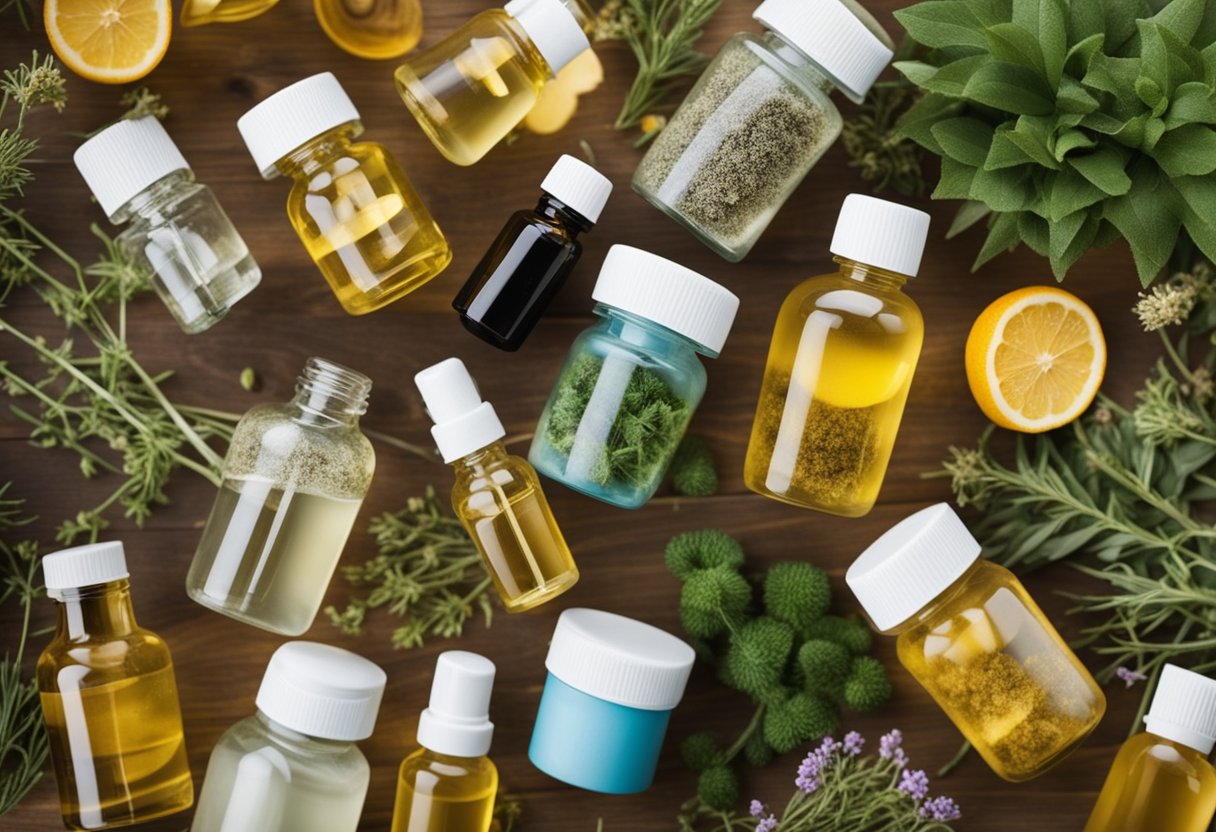Flea infestations can be a persistent nuisance, affecting the comfort of your pets and the cleanliness of your home. Traditional chemical treatments may not always be desirable or suitable, especially if you’re aiming for a non-toxic environment or have concerns about synthetic pesticides. Seeking natural remedies for flea control can be a safer, equally effective alternative. These non-toxic solutions range from household items you might already have to natural substances that are known for their insect-repellent properties.

To get rid of fleas naturally, you have several options that can be employed in various combinations for enhanced efficacy. Diatomaceous earth, for example, is a powder that can be used to treat your pets’ bedding and even be applied directly to their coats in moderation to dehydrate and kill fleas. In your home, you can utilize simple traps like a dish soap mixture to capture fleas, or employ a thorough cleaning regime that includes washing bedding and vacuuming regularly to remove fleas and their eggs from your environment.
Employing natural flea control remedies, you’re not only committing to the well-being of your pets but also ensuring a non-toxic living space for your entire family. With the right natural solutions, from diatomaceous earth to everyday household ingredients like baking soda and salt, keeping fleas at bay becomes a manageable task. Your approach should be persistent and consistent, as natural remedies may take a little more time to be fully effective compared to chemical treatments.
Understanding Flea Infestation
When your home and pets suffer from a flea infestation, it is crucial to understand the lifecycle of these parasites and the effects they have on your household and animals.
Lifecycle of Fleas
Fleas progress through a complex lifecycle, beginning as eggs that your pets often inadvertently spread around your house. These eggs hatch into larvae that feed on organic debris, including flea dirt—essentially dried blood excreted by adult fleas. Flea larvae weave cocoons to become pupae, which can remain dormant for weeks or months until environmental conditions are suitable. Finally, adult fleas emerge, seeking a host to continue their life cycle.
- Eggs: Typically laid on pets, these easily fall off into your home.
- Larvae: Feed on organic matter and flea dirt; avoid light and move deep into carpets or cracks.
- Pupae: The most resilient stage, resistant to most treatments.
- Adults: These parasites feed on blood, primarily from your pets, and can lay numerous eggs daily.
Effects on Pets and Household
Flea infestations primarily impact cats and dogs, but fleas can bite humans too, leading to irritation. Your pets may show signs of distress, such as excessive scratching, hair loss, and agitation, indicating the presence of fleas. Fleas carry a myriad of potential health issues, including flea allergy dermatitis and, in serious cases, anemia due to blood loss.
- Flea Dirt: A tell-tale sign of an infestation, resembling black pepper and indicating active adult fleas.
- Anemia: Occurs in severe cases where high numbers of fleas feed on a small or weakened animal.
- Allergies: Pets may be allergic to flea saliva, leading to intense itching and discomfort.
Preventative Measures for Flea Control

Fleas can be a persistent issue for pet owners, but by concentrating on cleanliness and environmental management, you can establish effective barriers against infestation.
Regular Cleaning and Vacuuming
Your first line of defense against fleas is maintaining a clean home. Frequent vacuuming is essential, as it removes fleas in various life stages from your carpets and furniture. Pay special attention to areas where your pet spends a lot of time, as well as any dark, hidden spaces where fleas might congregate.
- Daily to Weekly Vacuuming: Vacuum carpets, rugs, upholstery, and pet bedding regularly.
- Dispose of Vacuum Bags Promptly: Seal and discard vacuum bags immediately to prevent fleas from escaping.
Maintaining Your Yard
The state of your yard directly affects the likelihood of flea infestations. Keep your grass trimmed and remove debris where fleas can hide and lay eggs.
- Grass and Plant Care: Mow your lawn regularly to the proper height to discourage flea habitats.
- Debris Control: Clear away leaves, clippings, and branches promptly, and maintain shrubs and trees to minimize flea-hiding spots.
Natural Ingredients for Flea Repellent
When battling fleas, numerous natural ingredients are effective at repelling these pests. By incorporating certain essential oils, natural acids, and salts, you can create powerful, non-toxic repellents for use in your home and on your pets.
Essential Oils and Herbs
Herbal Repellents:
- Cedar: Fleas dislike the scent of cedar. Using cedar chips in pet bedding can help keep fleas at bay.
- Rosemary: A natural flea repellent, which can be used in a powdered form or as an oil. Sprinkle rosemary powder in areas where fleas are a problem or use diluted rosemary oil for a spray.
- Lavender Oil: Known for its flea repelling properties; add a few drops to a spray bottle with water to treat your pet’s bedding.
- Lemongrass Oil: Fleas are repelled by its scent. It can be mixed with water or vinegar to create a flea repellent spray.
- Cedar Oil: Useful in deterring a variety of pests including fleas, it can be mixed with water for a natural pet-friendly spray.
- Citronella Oil: Effective at repelling fleas and can be combined with other essential oils to boost effectiveness.
Natural Acids and Salts
Acidic Solutions:
- Vinegar: Both white vinegar and apple cider vinegar can create an inhospitable environment for fleas. A 1:1 solution of vinegar and water makes for a useful flea repellent spray.
- Lemon Juice: Contains citric acid, which is unappealing to fleas. A lemon wash can be prepared by steeping sliced lemons in boiling water, then cooling and applying the mixture.
Saline Mixtures:
- Salt: Fine salt can dehydrate and kill flea eggs when sprinkled onto carpets or flooring. For best results, vacuum after 12-48 hours to remove the salt and dead fleas.
It’s important that you use these ingredients with care. Essential oils in concentrated forms can be potent, and you should always do a spot test before applying them over larger areas or directly on your pets. And while natural ingredients are generally safer, they can still cause adverse reactions in some pets and people, so use them judiciously.
Home Remedies for Flea Treatment
Controlling fleas in your home and on your pets is possible with a variety of natural remedies. These approaches are especially useful if you prefer to avoid chemicals. Proper application and regular maintenance are key to effectiveness.
DIY Flea Traps and Deterrents
One simple and cost-effective flea trap involves a shallow dish of water mixed with dish soap. Set this under a night light and the fleas are attracted to the light, jump in, and are unable to escape due to the dish soap breaking the surface tension. Cedar chips can be another deterrent when placed in areas where pets sleep or play, as fleas dislike cedar’s natural oils. It’s also beneficial to sprinkle diatomaceous earth on carpets and furniture; it has desiccant properties that can dehydrate and kill fleas. Be sure to vacuum these areas regularly to remove fleas, their eggs, and larvae from your environment.
Natural Flea Treatments for Pets
When it comes to treating your pets, a bath with Dawn dish soap can act as a gentle flea eradicator. Rinse them thoroughly afterwards to prevent skin irritation. For an ongoing treatment, regularly cleanse your pet’s fur with a flea comb and wash pet beds and bedding in hot water to kill any remaining fleas. A natural pet shampoo may include ingredients like citrus, which is an effective flea repellent. After washing, an additional rinse with diluted apple cider vinegar (one part vinegar to ten parts water) can help keep fleas at bay. Always ensure any applied treatments or cleansers are pet-safe and well diluted to avoid any adverse reactions.
Minimizing Flea Risks in Pets
To effectively reduce the risk of flea infestations in your pets, regular bathing and grooming, as well as the correct use of flea prevention products are essential. Taking proactive steps can help keep your pet healthy and comfortable.

Bathing and Grooming
Regular bathing provides an opportunity to inspect your pet’s skin for signs of fleas, such as redness, inflammation, or tiny black or brown specks which could be flea feces. Use a mild shampoo and consider natural additives like coconut oil, which can soothe the skin and may have repellent properties. Post bath, grooming with a fine-toothed comb can help remove any remaining fleas and flea dirt from your pet’s fur.
Weekly Bathing Routine:
- Use warm water to keep your pet comfortable.
- Incorporate a natural flea-repellent shampoo additive like coconut oil.
Regular Grooming:
- Inspect for signs of fleas and brush your pet’s fur to distribute natural skin oils.
- Utilize a flea comb especially after baths to catch any leftover fleas.
Safe Use of Flea Collars and Products
When considering flea prevention, consult with your veterinarian to select safe and appropriate products. Tailor the use of flea collars or other flea prevention products to your pet’s specific needs, size, and health status. Always follow the manufacturer’s instructions to prevent any adverse reactions. Additionally, maintain the cleanliness of pet bedding to hinder flea lifecycle progression.
Flea Collar Usage:
- Ensure a proper fit, usually allowing two fingers to slip comfortably beneath the collar.
- Regularly check your pet’s neck area for any irritation.
Maintenance of Flea Prevention Products:
- Replace flea collars as recommended by the product guidelines.
- Treat pet bedding with natural sprays, like those containing witch hazel, for added protection.
Environmental Flea Control Strategies

Effective flea control involves not just treating your pets but also addressing flea populations in your environment. The strategies below are targeted at reducing flea infestations in both outdoor and indoor settings, making use of natural deterrents and cleaning methods.
Natural Outdoor Flea Deterrents
Your yard and lawn can unintentionally become breeding grounds for fleas. Implementing natural outdoor flea deterrents can greatly reduce the flea population outside your home, diminishing the chances of fleas making their way indoors.
- Nematodes: Beneficial nematodes are microscopic worms that are natural predators to flea larvae in the soil. They are effective non-chemical pest control agents.
- Natural Flea Repellents: Growing certain plants that naturally repel fleas can serve as a protective barrier for your yard. Plants such as rosemary, lavender, and peppermint not only repulse fleas but also enhance the aesthetic of your space.
Indoor Cleaning Techniques
Maintaining a clean indoor environment is crucial for controlling flea populations. Consistent cleaning disrupts the flea life cycle and reduces the risk of infestation.
- Steam Cleaning: Utilize a steam cleaner for your carpets, upholstery, and curtains. The high heat effectively kills flea eggs and larvae buried within fabrics.
- Diatomaceous Earth: This fine powder can be sprinkled on carpets and furniture. It dehydrates and kills fleas through its abrasive properties. Always use food-grade diatomaceous earth and follow the safety instructions.
Regular vacuuming, washing beddings in hot water, and periodically treating your pet’s favorite spots with natural flea deterrents keep your indoor environment less hospitable to fleas.

